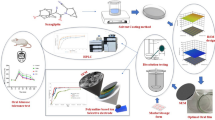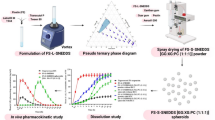Abstract
Carboxymethyl starch (CMS) is a pH-responsive excipient exhibiting also interesting properties for applications in delayed drug delivery systems. This work was aimed to investigate the release properties of monolithic and dry-coated tablets based on ionic sodium CMS and on protonated CMS, formulated with three model tracers: acetaminophen, acetylsalicylic acid (ASA), and sodium diclofenac. The sodium or protonated CMS were obtained from the same CMS synthesis by controlling the final pH of reaction media. The two forms of CMS were confirmed by the Fourier transform infrared spectroscopy. The in vitro dissolution profiles for monolithic and double core tablets were different and allowed a better understanding of characteristics of the two excipient forms. It was found that the protonated CMS exhibited a better stability in simulated gastric fluid in comparison to its sodium salt in monolithic dosage forms, whereas both excipients afforded a complete gastric protection of drugs when formulated as dry-coated dosages. Determination of water uptake and erosion rate of monolithic matrices based on the two CMS forms showed different mechanisms involved in the delivery of the three model active molecules in simulated intestinal media. When pancreatic enzymes were added in dissolution media, the drug release was accelerated showing that CMS is still a substrate for alpha-amylase. Both sodium and protonated starch excipients, formulated as dry-coated dosages, afforded a good gastro-protection and allowed a drug chronodelivery at various intervals up to 4–5 h. They could be considered as an alternative for delayed delivery and a solvent-free coating procedure.





Similar content being viewed by others
References
Adebisi AO, Conway BR. Modification of drug delivery to improve antibiotic targeting to the stomach. Ther Deliv. 2015;6(6):741–62.
Amidon S, Brown JE, Dave VS. Colon-targeted oral drug delivery systems: design trends and approaches. AAPS PharmSciTech. 2015;16(4):731–41.
Wulff R, Leopold CS. Coatings from blends of Eudragit(R) RL and L55: a novel approach in pH-controlled drug release. Int J Pharm. 2014;476(1–2):78–87.
Govender M, Choonara YE, Kumar P, du Toit LC, van Vuuren S, Pillay V. A review of the advancements in probiotic delivery: conventional vs. non-conventional formulations for intestinal flora supplementation. AAPS PharmSciTech. 2014;15(1):29–43.
Mateescu M-A, Ispas-Szabo P, Assaad E. Starch and derivatives as pharmaceutical excipients. In: Elsevier, editor. Controlled drug delivery: the role of self-assembling multi-task excipients. 1st ed. London: Woodhead Publishing; 2014. p. 21–84.
Rashid I, Al Omari MMH, Badwan AA. From native to multifunctional starch-based excipients designed for direct compression formulation. Starch - Stärke. 2013;65(7–8):552–71.
Ispas-Szabo P, Ravenelle F, Hassan I, Preda M, Mateescu MA. Structure–properties relationship in cross-linked high-amylose starch for use in controlled drug release. Carbohydr Res. 1999;323(1–4):163–75.
Mulhbacher J, Ispas-Szabo P, Lenaerts V, Mateescu MA. Cross-linked high amylose starch derivatives as matrices for controlled release of high drug loadings. J Control Release. 2001;76(1–2):51–8.
Wang HW, Kyriacos S, Cartilier L. Water uptake by substituted amylose tablets: experimentation and numerical simulation. Drug Dev Ind Pharm. 2010;36(4):371–8.
Colombo P, Bettini R, Santi P, Peppas NA. Swellable matrices for controlled drug delivery: gel-layer behaviour, mechanisms and optimal performance. Pharm Sci Technol Today. 2000;3(6):198–204.
Dumoulin Y, Alex S, Szabo P, Cartilier L, Mateescu MA. Cross-linked amylose as matrix for drug controlled release. X-ray and FT-IR structural analysis. Carbohydr Polym. 1998;37(4):361–70.
Rao YM, Veni JK, Jayasagar G. Formulation and evaluation of diclofenac sodium using hydrophilic matrices. Drug Dev Ind Pharm. 2001;27(8):759–66.
Gulrez SKH, Al-Assaf S. Hydrogels: methods of preparation, characterisation and applications. In: Angelo Carpi, editor. Progress in molecular and environmental bioengineering - from analysis and modeling to technology. Applications. InTech; 2011. p. 117–50. eBook.
Mateescu MA, Ispas-Szabo P, Assaad E. The concept of self-assembling and the interactions involved. Controlled drug delivery: the role of self-assembling multi-task excipients. London: Woodhead Publishing; 2014. p. 1–20.
Lemieux M, Gosselin P, Mateescu MA. Influence of drying procedure and of low degree of substitution on the structural and drug release properties of carboxymethyl starch. AAPS PharmSciTech. 2010;11(2):775–85.
Calinescu C, Nadeau E, Mulhbacher J, Fairbrother JM, Mateescu MA. Carboxymethyl high amylose starch for F4 fimbriae gastro-resistant oral formulation. Int J Pharm. 2007;343(1–2):18–25.
Calinescu C, Mulhbacher J, Nadeau E, Fairbrother JM, Mateescu MA. Carboxymethyl high amylose starch (CM-HAS) as excipient for Escherichia coli oral formulations. Eur J Pharm Biopharm. 2005;60(1):53–60.
Calinescu C, Mateescu MA. Carboxymethyl high amylose starch: chitosan self-stabilized matrix for probiotic colon delivery. Eur J Pharm Biopharm. 2008;70(2):582–9.
Calinescu C, Mondovi B, Federico R, Ispas-Szabo P, Mateescu MA. Carboxymethyl starch: chitosan monolithic matrices containing diamine oxidase and catalase for intestinal delivery. Int J Pharm. 2012;428(1–2):48–56.
Brouillet F, Bataille B, Cartilier L. High-amylose sodium carboxymethyl starch matrices for oral, sustained drug-release: formulation aspects and in vitro drug-release evaluation. Int J Pharm. 2008;356(1–2):52–60.
Nabais T, Brouillet F, Kyriacos S, Mroueh M, Amores da Silva P, Bataille B, et al. High-amylose carboxymethyl starch matrices for oral sustained drug-release: in vitro and in vivo evaluation. Eur J Pharm Biopharm. 2007;65(3):371–8.
Lemieux M, Gosselin P, Mateescu MA. Carboxymethyl high amylose starch as excipient for controlled drug release: mechanistic study and the influence of degree of substitution. Int J Pharm. 2009;382(1–2):172–82.
Assaad E, Mateescu MA. The influence of protonation ratio on properties of carboxymethyl starch excipient at various substitution degrees: structural insights and drug release kinetics. Int J Pharm. 2010;394(1–2):75–84.
Lin SY, Lin KH, Li MJ. Formulation design of double-layer in the outer shell of dry-coated tablet to modulate lag time and time-controlled dissolution function: studies on micronized ethylcellulose for dosage form design (VII). AAPS J. 2004;6(3):e17.
Oddsson E, Gudjonsson H, Thjodleifsson B. Endoscopic findings in the stomach and duodenum after treatment with enteric-coated and plain naproxen tablets in healthy subjects. Scand J Gastroenterol. 1990;25(3):5.
Sadeghi F, Ford JL, Rajabi-Siahboomi A. The influence of drug type on the release profiles from Surelease-coated pellets. Int J Pharm. 2003;254(2):123–35.
Chan FKL, Lanas A, Scheiman J, Berger MF, Nguyen H, Goldstein JL. Celecoxib versus omeprazole and diclofenac in patients with osteoarthritis and rheumatoid arthritis (CONDOR): a randomised trial. Lancet. 2010;376(9736):173–9.
Massimo Claar G, Monaco S, Del Veccho Blanco C, Capurso L, Fusillo M, Annibale B. Omeprazole 20 or 40 mg daily for healing gastroduodenal ulcers in patients receiving non-steroidal anti-inflammatory drugs. Aliment Pharmacol Ther. 1998;12(5):463–8.
Sugano K, Kinoshita Y, Miwa H, Takeuchi T, Esomeprazole NPSG. Safety and efficacy of long-term esomeprazole 20 mg in Japanese patients with a history of peptic ulcer receiving daily non-steroidal anti-inflammatory drugs. BMC Gastroenterol. 2013;13:54.
Rostom A, Wells G, Tugwell P, Welch V, Dube C, McGowan J. The prevention of chronic NSAID induced upper gastrointestinal toxicity: a Cochrane collaboration metaanalysis of randomized controlled trials. J Rheumatol. 2000;27(9):2203–14.
Goldstein JL, Larson LR, Yamashita BD. Prevention of nonsteroidal anti-inflammatory drug-induced gastropathy: clinical and economic implications of a single-tablet formulation of diclofenac/misoprostol. Am J Manag Care. 1998;4(5):687–97.
Altman R, Bosch B, Brune K, Patrignani P, Young C. Advances in NSAID development: evolution of diclofenac products using pharmaceutical technology. Drugs. 2015;75(8):859–77.
US Pharmacopeia 38 - National Formulary 33. United States Pharmacopeial Convention Inc. Rockville, MD. USA. 2015.
Schell HD, Serban M, Mateescu MA, Bentia T. Acid and basic amylose ionic exchangers. Rev Roum Chim. 1978;23:1143–7.
Mulhbacher J, Mateescu MA, Calinescu C. Composition comprising polymeric material and uses thereof. 2008. Patent US20080286253.
Freichel OL, Lippold BC. A new oral erosion controlled drug delivery system with a late burst in the release profile. Eur J Pharm Biopharm. 2000;50(3):345–51.
Kavanagh N, Corrigan OI. Swelling and erosion properties of hydroxypropylmethylcellulose (Hypromellose) matrices—influence of agitation rate and dissolution medium composition. Int J Pharm. 2004;279(1–2):141–52.
Sungthongjeen S, Puttipipatkhachorn S, Paeratakul O, Dashevsky A, Bodmeier R. Development of pulsatile release tablets with swelling and rupturable layers. J Control Release. 2004;95(2):147–59.
Silverstein RM, Webster FX, Kiemle DJ, Bryce DL. Spectrometric identification of organic compounds. 8th Edition. New York: Wiley; 2014. p. 81–108.
Garekani HA, Sadeghi F, Ghazi A. Increasing the aqueous solubility of acetaminophen in the presence of polyvinylpyrrolidone and investigation of the mechanisms involved. Drug Dev Ind Pharm. 2003;29(2):173–9.
Voelker M, Hammer M. Dissolution and pharmacokinetics of a novel micronized aspirin formulation. Inflammopharmacology. 2012;20(4):225–31.
Bartolomei M, Bertocchi P, Antoniella E, Rodomonte A. Physico-chemical characterisation and intrinsic dissolution studies of a new hydrate form of diclofenac sodium: comparison with anhydrous form. J Pharm Biomed Anal. 2006;40(5):1105–13.
Palomo ME, Ballesteros MP, Frutos P. Analysis of diclofenac sodium and derivatives. J Pharm Biomed Anal. 1999;21(1):83–94.
Mulhbacher J, Ispas-Szabo P, Mateescu MA. Cross-linked high amylose starch derivatives for drug release. II. Swelling properties and mechanistic study. Int J Pharm. 2004;278(2):231–8.
Lazik W, Heinze T, Pfeiffer K, Albrecht G, Mischnick P. Starch derivatives of a high degree of functionalization. VI. Multistep carboxymethylation. J Appl Polym Sci. 2002;86(3):743–52.
Heinze TH, Pfeiffer K, Lazik W. Starch derivatives with high degree of functionalization. III. Influence of reaction conditions and starting materials on molecular structure of carboxymethyl starch. J Appl Polym Sci. 2001;81(8):2036–44.
Heinze TTP, HEINZE U. Starch derivatives of high degree of functionalization. 1. Effective, homogeneous synthesis of p-toluenesulfonyl (tosyl) starch with a new functionalization pattern. Carbohydr Polym. 2000;42:411–20.
Massicotte LP, Baille WE, Mateescu MA. Carboxylated high amylose starch as pharmaceutical excipients. Structural insights and formulation of pancreatic enzymes. Int J Pharm. 2008;356(1–2):212–23.
Al-Taani BM, Tashtoush BM. Effect of microenvironment pH of swellable and erodable buffered matrices on the release characteristics of diclofenac sodium. AAPS PharmSciTech. 2003;4(3):E43.
Liu J, Stephens JD, Kowalczyk BR, Cetinkaya C. Real-time in-die compaction monitoring of dry-coated tablets. Int J Pharm. 2011;414(1–2):171–8.
Piana F, Case DH, Ramalhete SM, Pileio G, Facciotti M, Day GM, et al. Substituent interference on supramolecular assembly in urea gelators: synthesis, structure prediction and NMR. Soft Matter. 2016;12(17):4034–43.
Xiang Y, Moulin E, Buhler E, Maaloum M, Fuks G, Giuseppone N. Hydrogen-bonded multifunctional supramolecular copolymers in water. Langmuir. 2015;31(28):7738–48.
Lenaerts V, Moussa I, Dumoulin Y, Mebsout F, Chouinard F, Szabo P, et al. Cross-linked high amylose starch for controlled release of drugs: recent advances. J Control Release. 1998;53(1–3):225–34.
Acknowledgments
Thanks are due to NSERC of Canada for the financial support of this research (MAM) and for a Canada fellowship for doctoral studies (CC).
Author information
Authors and Affiliations
Corresponding author
Rights and permissions
About this article
Cite this article
Ispas-Szabo, P., De Koninck, P., Calinescu, C. et al. Carboxymethyl Starch Excipients for Drug Chronodelivery. AAPS PharmSciTech 18, 1673–1682 (2017). https://doi.org/10.1208/s12249-016-0634-8
Received:
Accepted:
Published:
Issue Date:
DOI: https://doi.org/10.1208/s12249-016-0634-8




